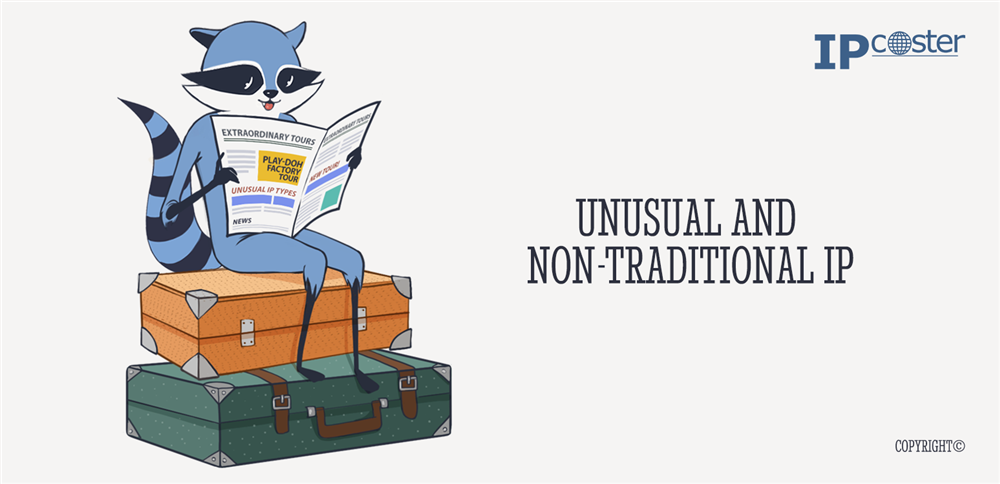IP-Academy

Unusual and Non-Traditional IP
Intellectual property is a pinnacle of modern society, with a multitude of popular cultures being governed by undercurrents of IP without many realising. From chart music to toy brands and beyond, there is much to explore when it comes to some of the most well-known and non-traditional intellectual property, and we have explored some of the finest examples.
Trademarks are one of the most valuable types of IP used by some of the biggest powerhouses in all industries, and whilst many marks are more traditional, some businesses have chosen to go down a more atypical route, resulting in some of the most well-known and recognisable IP.
These include the toy company Hasbro, which took a chance on, and successfully registered, the iconic and widely recognised Play-Doh scent on May 15, 2018 with the United States Patent and Trademark Office (USPTO).
Whilst not unheard of, scent marks are among one of the lesser obtained trademark types, due to the more stringent requirements which need to be met in order to obtain scent mark protection. In the US for example, it is outlined that the "amount of evidence required to establish that a scent or fragrance functions as a mark is substantial".
Such evidence is required to demonstrate that the scent itself has acquired distinctiveness. Further, the scent of the item should not be an important practical function, rather, it should merely assist as an identifying element used to distinguish the brand to which it relates.
Play-Doh managed to achieve this feat, with the scent described on the trademark register as a "sweet, slightly musky, vanilla fragrance, with slight overtones of cherry, combined with the smell of a salted, wheat-based dough." Although a vast majority may not pick up on the particulars of the fragrance by simply smelling it, the nostalgic scent is distinctive enough on the whole to be recognisable to many as the smell which belongs to Play-Doh. The scent has also been released as a perfume, which would no doubt be a niche and memorable gift to anyone with fond memories of using Play-Doh.
Unlike trademark protection, copyright can prove more nuanced when it comes to lesser traditional forms of creative work. Commonly, people would consider paintings or literary works as typical copyright works, but tattoo artist S. Victor Whitmill made headlines with regards to his iconic tattoo design made especially for the boxing legend Mike Tyson. The tattoo, which was initially created in 2003 by Mr. Whitmill, created a stir when seen in the hit film "The Hangover II". The film depicted a character played by Ed Helms sporting the tattoo on his face, duplicating the design created for Tyson.
A mere few weeks prior to the release of the film, which ended up becoming the highest grossing comedy film to date, Whitmill instigated copyright infringement proceedings against Warner Brothers over the use of the tattoo design. Whilst the initially sought after preliminary injunction was denied, the Judge noted there was merit to the case and the lawsuit ensued. The case was settled with the terms kept under lock and key, however, Warner Brothers acknowledged a few weeks before a conclusion was reached that they may have considered digitally altering the tattoo so as to eliminate potential infringement.
The unusual case not only sheds light on the complexities of intellectual property protection in a fast evolving digital landscape, but on the intricacies of copyright as a whole. Whilst other works such as art pieces or literary novels have a plethora of legal precedent surrounding their protection, tattoos are more unique in terms of copyright protection.
Copyright law in the UK allows the designer of the tattoo to enjoy the IP rights to the piece, entitling them to any royalties should an image of the tattoo be reproduced. This means that even though the tattoo may be unique to you, but a tattoo artist designed it, the copyright will lay with the artist. On the other hand, if a person creates a tattoo design themselves, the copyright will belong to them. These lines of copyright ownership can become blurred in cases where an artist is commissioned, for example, to create a custom design using your ideas, at which point joint ownership may be considered.
Whilst protecting more obscure or unusual intellectual property possesses its risks and requires much thought, trademarks such as Play-Doh and copyright battles such as Whitmill's tattoo design demonstrate that risks can pave the way to great reward when it comes to IP. If you would like advice on the protection of your intellectual property, please contact us.